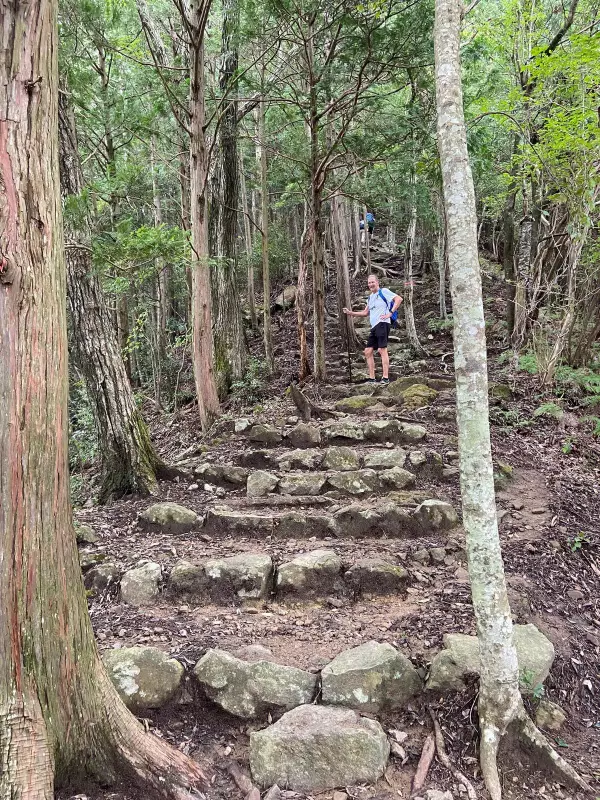
Embracing Japanese Hospitality in Remote Hongu
When Ray and Leonie Wilson arrived at Blue Sky Guesthouse in the remote village of Hongu, they were greeted with impeccable Japanese hospitality that would define their entire mountain adventure. Their host, Mr Naoya Yamamoto, immediately won them over with his gracious manners and traditional approach, addressing Ray as "Raymond-san" from their first email exchange.
The Wilsons had paid approximately $560 for four nights in advance at the guesthouse located in this 500-person village on the Kii Peninsula south of Osaka. Their traditional Japanese room offered minimal furniture - just a low coffee table with futons stored in cupboards - requiring some creative maneuvering to navigate the floor space.
Mr Yamamoto proved to be genuinely authentic, even when explaining the nocturnal roof disturbances came from macaque monkeys, and casually mentioning that locals occasionally fired air rifles to discourage the animals from establishing territory in the area.
Unexpected Encounters and Perth Sand
The surprises began even before reaching Hongu. During their first day in Kii Tanabe, approximately 56km away on the coast, the couple visited the Exotic Moo Cafe where they encountered Bebe, a three-year-old pig who confidently wandered through the establishment as if he owned the place.
Later, their accommodation host Yuhei revealed an astonishing connection to Australia during a tour of nearby Shirahama beach resort. The beach's strikingly white sand actually originated from Perth, shipped over in the 1990s to maintain the area's status as a popular resort destination.
Ancient Pilgrimage Trails and Sacred Sites
Hongu sits at the heart of the Kii Peninsula's sacred landscape, important to both Shinto and Buddhist worshippers for centuries. The area forms a confluence of Kumano Kodo pilgrimage routes - a network of trails dating back more than 1000 years with World Heritage designation.
The village pulses with spiritual significance despite its sleepy pace. The magnificent Kumano Hongu Taisha shrine has drawn pilgrims for centuries, while just down the road stands Japan's largest torii gate at 340 metres tall, marking the original site of the first Hongu Taisha shrine alongside the sacred Kumano-gawa River.
Conquering the Mountain Trails
Ray and Leonie came primarily to walk the ancient mountain and forest trails, which offered both breathtaking views and physically demanding challenges. Their Japanese language skills proved inadequate for navigating place names like Hosshinmon, Inohana, and Tsukimigaoka-jinja, making Google Translate an essential tool.
Despite Mr Yamamoto's concerns about their fitness for challenging routes, the couple embarked on the demanding Hongu Loop. They began with the Dainichi-goe trail to Yunomine, a 2.2km section requiring one to two hours to complete with a steep ascent severe enough to "give you nose bleed" in 33°C heat with 75% humidity.
The trail presented constant challenges with gnarly tree roots, slippery ancient stones, and rubble underfoot. They encountered only half a dozen fellow hikers along paths winding through forests of cedar, cypress, maple, hemlock, and pine trees.
Bear Warnings and Pilgrim Legends
Their next challenge was the Akagi-goe trail, where an alarming notice immediately caught their attention: "BEWARE OF BEARS! A bear has been discovered around the area at 10pm on July 1. DO NOT RUN AWAY or they will come at you. Stay still until they are gone."
Along the path, they discovered historical markers including the remains of the Kakihara-jaya Teahouse and learned about legendary holy figure Ippen Shonin, who walked these same paths in the 13th century. The couple embraced the local legends, with Leonie affectionately nicknaming Ray "Shokai" after the saint's servant.
Before their ascent, a kindly elderly Japanese couple provided them with onsen tamago - eggs cooked in hot springs for about 18 minutes - which proved to be delicious fuel for their journey.
Triumphant Return and Coastal Explorations
After five hours of hiking from Yunomine to Hosshinmon, the exhausted but accomplished couple caught a bus back to Hongu, where a relieved Mr Yamamoto greeted them with beaming smiles and numerous questions about their adventure.
Their journey continued to Shingu on the east coast before traveling to Shimosato to stay with eccentric artist Yukine and her husband. Here they visited the impressive Nachi Taisha shrine with its three-storey pagoda and dramatic 133-metre Nachi waterfall backdrop.
During their four-hour train trip back to Osaka, the Wilsons reflected on their extraordinary fortune in choosing the Kii Peninsula, realizing that even without religious devotion, their walks through these mountains - considered the home of gods since ancient times - had created unforgettable memories.





